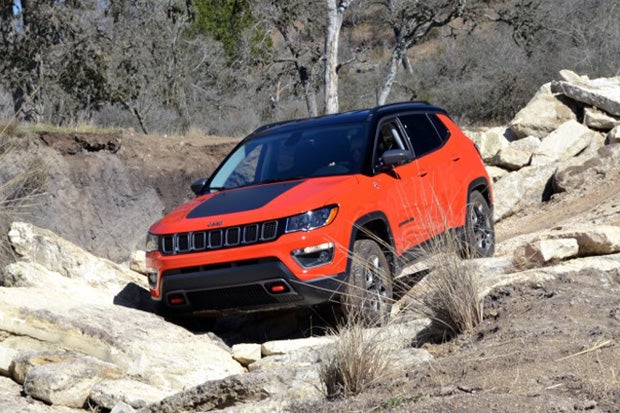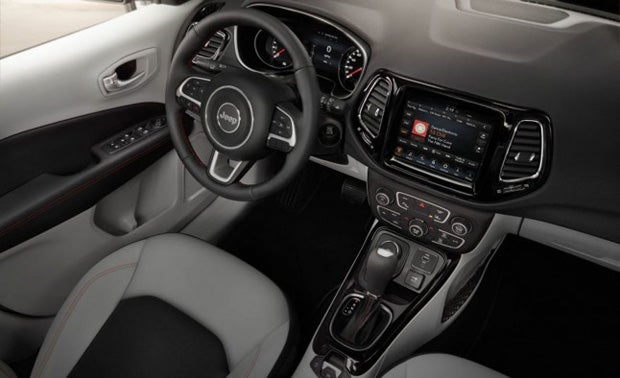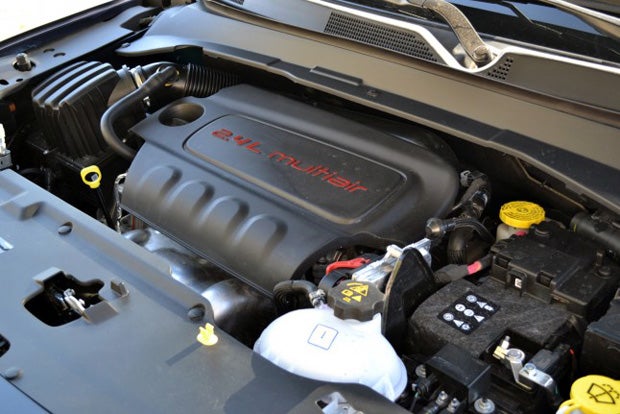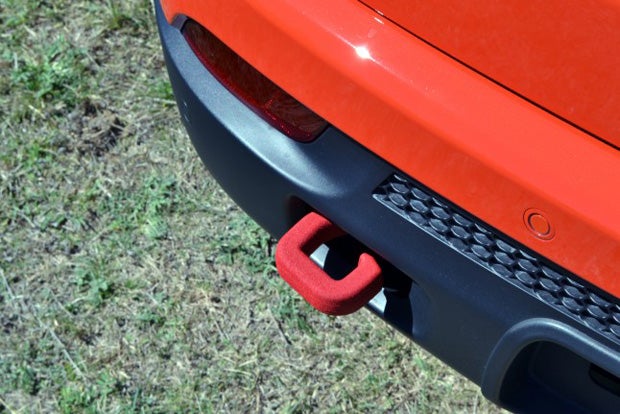
Thereís plenty of evidence to support the claim that the 2017 Jeep Compass is the most capable compact crossover on the market.
Fast Facts
Engine: 2.4L 4-cylinder
Output: 180 hp, 175 lb-ft
Transmission: 6-speed manual; 6-speed auto; 9-speed auto
Fuel Economy (MPG): 22 city, 30 hwy (AWD)
Price: Starts at $20,995
Like the way it handles mud, or rocks, or even water crossings. Believe it or not, that ĎTrail Ratedí badge on the fender actually means something, and helps set the Compass apart from its competitors when the pavement ends. And while that ruggedness is all well and good, it matters very little when it comes to the crossoverís ability to tackle far less exciting tasks, like commuting, or a trip to Costco, or taking the kids to school. Thankfully, this new Compass has what it takes to do a decent job at that stuff, too.
Where Form Meets Function
After a long and successful decade on the market, the first-generation Compass ó along with its fraternal twin, the Patriot ó was in desperate need of an update in the fight for small CUV supremacy. That Jeep brass ditched the Patriot in favor of the Compass looks fortuitous given todayís political climate. Itís hard to imagine a scenario where a Mexican-made vehicle emblazoned with a ĎPatriotí badge would endear itself to the buying public.

Diplomatic digression aside, the 2017 Compass joins a growing roster of overhauled entrants in the ultra-competitive compact crossover segment. To help set it apart, the Compass features an all-new aesthetic that leans heavily on the Jeep Grand Cherokee. See the Compass from a distance, and itís tough to distinguish it from its larger ó and pricier ó sibling.
Its wheels have been pushed as close to the corners as possible, the way a Jeepís should, which aids both form and function. Built on an elongated version of the platform that underpins the Jeep Renegade, the Compass rides on a wheelbase that measures 103.8 inches (2,636 millimeters), while its overall length stretches 173 inches (4,394 mm).
Likewise, the compact crossoverís ride height meets the bare minimum of what a Jeep should. Standing anywhere from 7.8 inches (198 mm) to 8.5 inches (216 mm) from the ground depending on trim, the Compass has just enough room underneath to clear obstacles without looking like itís on stilts. It results in a short and stout appearance thatís complemented by sculpted lines that flow nicely from front to back.

A Cozy Cabin
Taking its exterior measurements into account, the Compass is among the segmentís smallest entrants. It does, however, offer an impressive amount of passenger space in spite of those pint-sized proportions. With plenty of head-, leg- and shoulder room up front, the Compassí cabin feels much larger from either front seat than its cute-ute dimensions would suggest. Helping matters is the clutter-free design thatís been employed up front, with a streamlined center console taking up very little room between the seats.
The rest of the Compassís cockpit is clean and streamlined, and features familiar buttons and knobs for climate and audio controls on the center stack beneath a trio of infotainment touchscreen options. Standard on Trailhawk and Limited models, an 8.5-inch touchscreen features Apple CarPlay and Android Auto smartphone compatibility, while running the latest version of the user-friendly Uconnect infotainment interface. A downsized 7-inch version is standard on lower trims.
There are some sacrifices, though, namely a pair of cup holders that are positioned awkwardly towards to the back storage bin, and no cubby for a cellphone to park while plugged into the USB charging port ahead of the gear lever.
Space in the second row shrinks somewhat, though thereís more than enough space to accommodate adults with comfort. While it doesnít quite compare to the absurdly large Honda CR-V, the 38.3 inches (973 mm) of rear legroom in the Compass isnít likely to leave anyone this side of a 36-inch inseam feeling cramped. And just like the segment-leading CR-V, the Compass features rear doors that swing open almost 90° for easy access to the second row.
Itís only when it comes to carrying cargo that the Compass comes up well short of most of the competitive set. With 27.2 cu-ft (770 liters) of space behind the rear seats and 59.8 cu-ft (1,693 liters) with them folded, cargo capacity is significantly smaller than virtual everything else in the segment. The Compass does, however, offer more than enough space for day-to-day use, and benefits from a wide rear cargo opening that isnít hampered by awkwardly shaped taillight housings. The same goes for the rear wheel wells, which arenít overly intrusive, and leave plenty of space for stuff.
A Comfortable Ride
Out on the road, the 2017 Jeep Compass drives nicely, and has the borderline premium feel of the Grand Cherokee. The suspension does well to absorb bumps and cracks in the pavement without feeling too soft. Itís forgiving to be sure, but errs on the firm side, leaving almost no room for body roll.
The Compassí steering is also surprisingly responsive, a product, no doubt, of its wheels sitting so close to the corners. When combined with the taut suspension, the Compass displays a level of agility not often found in the compact crossover segment and is impressively engaging to drive.

Where the new Compass falters somewhat is its engine. Employing the same 2.4-liter four-cylinder used extensively by Fiat Chrysler Automobiles, the naturally-aspirated engine feels somewhat underpowered under the hood of the Compass. With 180 horsepower and 175 lb-ft of torque on tap, output is less than abundant, and, when combined with the available nine-speed automatic transmission, feels gutless under acceleration. Making matters worse is the amount of engine noise that penetrates the cabin. It sounds about as pesky as the last Compass when the pedal is pressed, and could benefit from some additional sound-deadening in the dash.
Joining the nine-speed transmission is a pair of six-speed gearboxes, one manual and one automatic, that were unavailable during our drive in Texas.
Regardless of transmission choice, the Compass is rated at a combined 25 mpg when power is sent to all four wheels. (Canadian fuel economy figures have yet to be released, but expect nothing more than a slight variance if there is one at all.) After 180 miles (290 kilometers) of driving in and around San Antonio, our tester, a fully-loaded Limited model, showed a combined average of 23 mpg (10.2 L/100 km).

Tackling Trails
For all its on-road manners, of which the Compass has plenty, it feels equally at home when the pavement ends. Opt for Trailhawk trim, and the Compass will easily traverse trails a small CUV has no business being on.
Dressed to look the part, the Trailhawk is finished quite differently than the remaining Compass models, and features plenty of black plastic trim aimed at protecting it out on the trail, as well as reworked bumpers front and rear. With its cumbersome front air dam removed in Trailhawk trim, the Compassí approach angle is almost doubled to an impressive 30.3°, while its departure angle sits at a comfortable 33.6°. Its breakover angle has also been improved to 24.4°, while a bunch of skid plates have been bolted on to protect vital components like the front suspension, transmission, and fuel tank.
Arriving at a working ranch north of San Antonio, we climbed out of the comfortable confines of our Limited tester and into one of the waiting Trailhawks. Finished in screaming orange paint, it stood in stark contrast to the subdued atmosphere we were surrounded by. With the four-wheel drive system set to low range and the traction management dial turned to the Trailhawk-exclusive ĎRockí setting, we set out on the heels of a Wrangler Unlimited.
It didnít take long before the Compass encountered its first serious obstacle: An articulating portion of chassis-twisting trail. We approached slowly, the passenger side front wheel dropping into a deep rut first, followed by the driverís side rear wheel lifting well into the air. With an incredible amount of torsional rigidity there was no creaking or contorting to report, the Compass cooly carrying on.
The same was true for much of the rest of the trail, with little standing in the way of the Compass and its combination of an aggressive 20:1 crawl ratio, stiff chassis and impressive suspension travel. Its last salvo was, of course, its toughest: A series of undulating boulders. While the section put the Trailhawkís skid plates to the test, it was easily up to the task of crawling its way out without much trouble.
The Verdict: 2017 Jeep Compass Review
As capable as the 2017 Jeep Compass is, itís likely that few, if any, owners will ever find out. Its reputation for ruggedness will, however, help mask some of its shortcomings. Its reasonable price wonít hurt either. A base model with a six-speed manual gearbox and front-wheel drive will fetch $20,995, while a top-of-the-line Limited starts at $28,995. A trail-riding Trailhawk, meanwhile, is priced at $28,495. Of course, tacking on any of the Compassí available options packages will run up the cost rather quickly, easily rising to the mid-$30,000 range. But like most obstacles thrown the Compassí way, that price is pretty easy to get over.
Love It
Design inside and out
Off-road ability
Ride and handling
Leave It
Meager acceleration
Noisy cabin
Small cargo area


 Your Privacy Choices
Your Privacy Choices